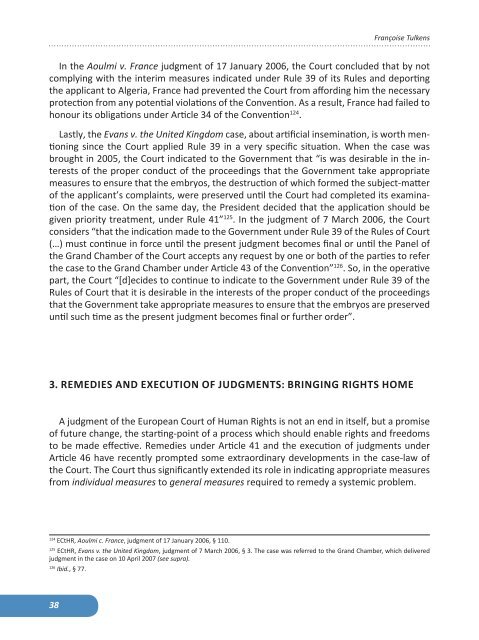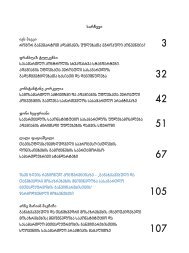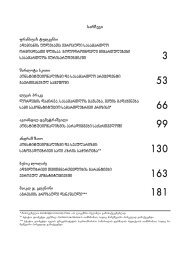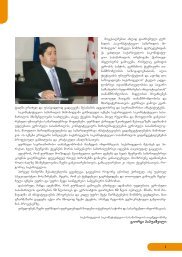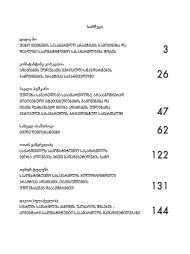Contents - Constitutional Court of Georgia
Contents - Constitutional Court of Georgia
Contents - Constitutional Court of Georgia
You also want an ePaper? Increase the reach of your titles
YUMPU automatically turns print PDFs into web optimized ePapers that Google loves.
38<br />
Françoise Tulkens<br />
In the Aoulmi v. France judgment <strong>of</strong> 17 January 2006, the <strong>Court</strong> concluded that by not<br />
complying with the interim measures indicated under Rule 39 <strong>of</strong> its Rules and deporting<br />
the applicant to Algeria, France had prevented the <strong>Court</strong> from affording him the necessary<br />
protection from any potential violations <strong>of</strong> the Convention. As a result, France had failed to<br />
honour its obligations under Article 34 <strong>of</strong> the Convention 124 .<br />
Lastly, the Evans v. the United Kingdom case, about artificial insemination, is worth mentioning<br />
since the <strong>Court</strong> applied Rule 39 in a very specific situation. When the case was<br />
brought in 2005, the <strong>Court</strong> indicated to the Government that “is was desirable in the interests<br />
<strong>of</strong> the proper conduct <strong>of</strong> the proceedings that the Government take appropriate<br />
measures to ensure that the embryos, the destruction <strong>of</strong> which formed the subject-matter<br />
<strong>of</strong> the applicant’s complaints, were preserved until the <strong>Court</strong> had completed its examination<br />
<strong>of</strong> the case. On the same day, the President decided that the application should be<br />
given priority treatment, under Rule 41” 125 . In the judgment <strong>of</strong> 7 March 2006, the <strong>Court</strong><br />
considers “that the indication made to the Government under Rule 39 <strong>of</strong> the Rules <strong>of</strong> <strong>Court</strong><br />
(…) must continue in force until the present judgment becomes final or until the Panel <strong>of</strong><br />
the Grand Chamber <strong>of</strong> the <strong>Court</strong> accepts any request by one or both <strong>of</strong> the parties to refer<br />
the case to the Grand Chamber under Article 43 <strong>of</strong> the Convention” 126 . So, in the operative<br />
part, the <strong>Court</strong> “[d]ecides to continue to indicate to the Government under Rule 39 <strong>of</strong> the<br />
Rules <strong>of</strong> <strong>Court</strong> that it is desirable in the interests <strong>of</strong> the proper conduct <strong>of</strong> the proceedings<br />
that the Government take appropriate measures to ensure that the embryos are preserved<br />
until such time as the present judgment becomes final or further order”.<br />
3. REMEDIES AND EXECUTION OF JUDGMENTS: BRINGING RIGHTS HOME<br />
A judgment <strong>of</strong> the European <strong>Court</strong> <strong>of</strong> Human Rights is not an end in itself, but a promise<br />
<strong>of</strong> future change, the starting-point <strong>of</strong> a process which should enable rights and freedoms<br />
to be made effective. Remedies under Article 41 and the execution <strong>of</strong> judgments under<br />
Article 46 have recently prompted some extraordinary developments in the case-law <strong>of</strong><br />
the <strong>Court</strong>. The <strong>Court</strong> thus significantly extended its role in indicating appropriate measures<br />
from individual measures to general measures required to remedy a systemic problem.<br />
124 ECtHR, Aoulmi c. France, judgment <strong>of</strong> 17 January 2006, § 110.<br />
125 ECtHR, Evans v. the United Kingdom, judgment <strong>of</strong> 7 March 2006, § 3. The case was referred to the Grand Chamber, which delivered<br />
judgment in the case on 10 April 2007 (see supra).<br />
126 Ibid., § 77.


